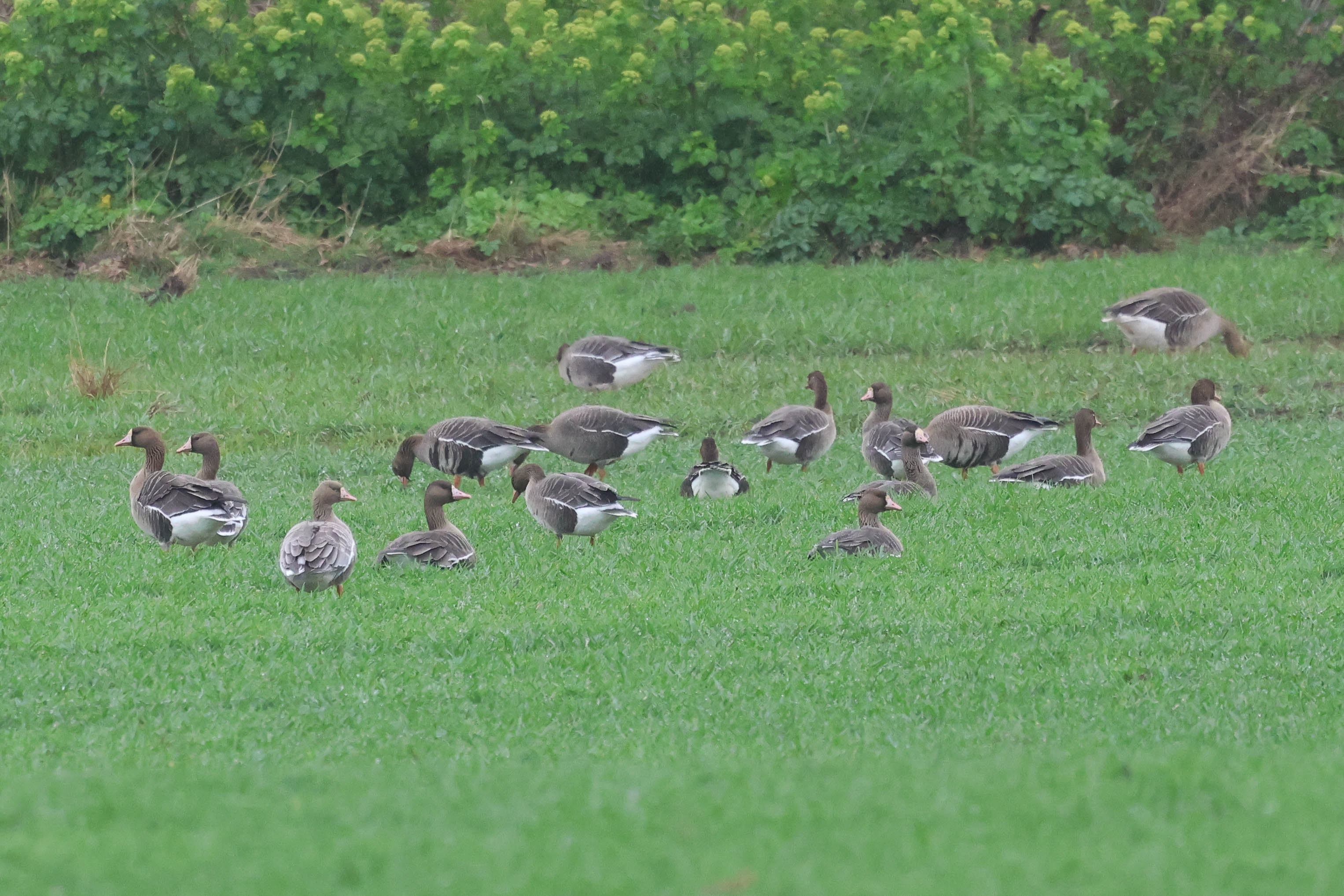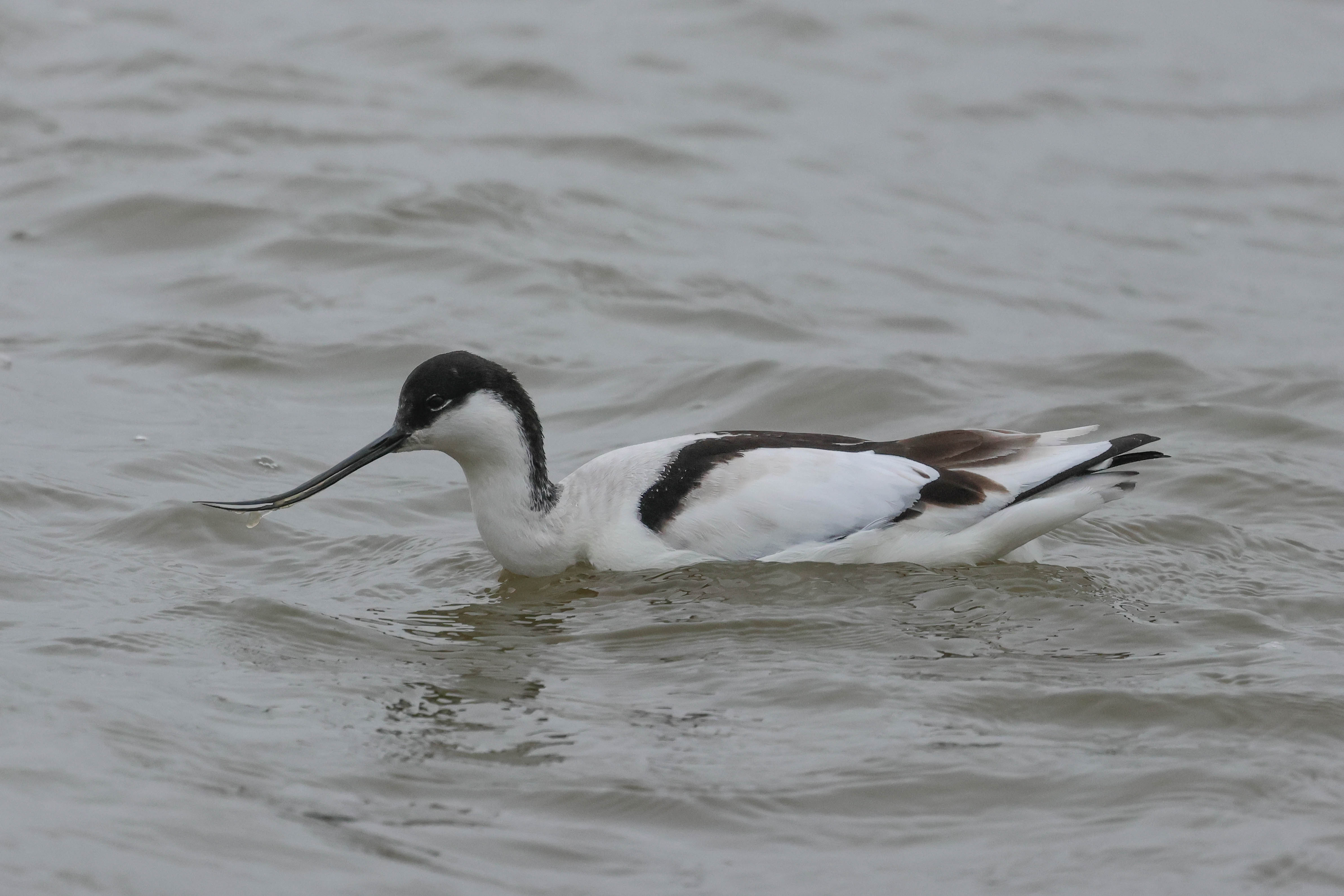Day 2 of an Early Spring 3-day tour. The weather forecast for today was really terrible – either heavy rain all morning and light rain all afternoon, or the other way round, depending on which half of the Met Office forecast you wanted to believe (nothing like hedging your bets!). Other forecasts were similar, it was definitely going to rain all day. At least there is one reliable thing about the weather forecast though, and that is that it is regularly wrong. As it turned out, it was grey and damp all day, with a cold NNW wind, but it barely rained at all!
There was some light drizzle when we met first thing, but by the time we got up to the coast it had stopped. We headed first for Wells and walked up from the beach car park towards the new lifeboat station. There were lots of gulls on the grass island beyond the outer harbour, mainly Herring Gulls but quite a few Lesser Black-backed Gulls in with them.
Out towards the beach, there were several Brent Geese feeding along the near edge of the harbour channel. We could see several Red-breasted Mergansers in the water distantly further up, then three appeared in the channel right in front of us. We had a very good view now in the scope. They were swimming against the falling tide, diving, but that meant they were back on to the wind. Red-breasted Mergansers look like they are having a bad hair day at the best of time, but it was on a new level now!

There were a couple of Common Seals on the sandbar in the middle of the channel and lots of waders on the sand beyond. Lots of Oystercatchers were scattered liberally around and a huddle of Sanderling were sheltering in a small depression in the sand. Several Bar-tailed Godwits were feeding in the edge of the water and we got the scope on them for a closer look. Round the corner, we managed to get out of the wind behind the groynes. There were more waders here – Dunlin, Knot, Grey Plover and Ringed Plover.

It was staying dry, so we walked back round to the minibus, and drove on to Holkham. Out on the grazing marshes by Lady Anne’s Drive we could still see quite a few Wigeon, but again numbers are dropping here too. There were plenty of Greylags, but no sign of any Pinkfeet here now. A couple of Grey Herons where sheltering in the lee of the brambles. Scanning the grass from the top of the drive, the resident pair of Grey Partridge were quickly located. A Red Kite drifted over and we stopped to look at a Mistle Thrush in the trees.

It was windy as we came out of the pines the other side. We walked briskly down towards the cordon, just stopping to look at several Meadow Pipits out on the saltmarsh. There had still been five Shorelarks here yesterday, despite it getting late for them here now, but there was no sign of them today. It had rained a lot overnight and it was blustery out here. We walked down to the far end scanning, which produced another pair of Grey Partridge which flew out and a couple more Meadow Pipits. It was too windy out on the beach, so we just paused for a quick scan through the gap as we walked round the end. There was no sign of anything on the sea but it was very rough.
As we walked back, one Skylark was up and singing now. We scanned out across the beach and the Gap – the beach warden was very busy, zooming up and down the saltmarsh in his ATV telling people to put their dogs on leads, after they had just walked past the big signs which have been put up to say dogs must be on leads from today! We did pick up a pair of Stonechats flitting around the low vegetation on the far side of the Gap path. There were more Meadow Pipits here too, but we couldn’t find a Rock Pipit today. Back through the pines, it was more sheltered and remarkably, we had stayed dry. As we got back to the minibus it just started to spit with very light rain. Perfect timing!
As we drove west, we noticed lots of geese in the field by the road so we pulled up to check. They were mainly White-fronted Geese, at least a hundred, a nice comparison with a smaller number of Greylags alongside, though unfortunately there was nowhere to stop here and get out. Lots of Egyptian Geese were gathered in the field on the other side of the road.

We headed over to Titchwell for lunch and the rain had quickly stopped on the way so we could eat out on the picnic tables. A Treecreeper was singing in the trees behind and a couple of Long-tailed Tits appeared in the alders above our heads.
After lunch, we walked out onto the reserve. There were a few geese on the Thornham grazing marsh, so we set up the scope to check through. Four Pink-footed Geese were still in with the Greylags, smaller with dark heads and darker more delicate bills. A couple of Marsh Harriers circled out over the reedbed and a Common Buzzard in the dead trees at the back was mobbed by another Marsh Harrier. A succession of Mediterranean Gulls flew overhead calling. A few Tufted Ducks and Common Pochard were diving on the reedbed pool.
We headed for the shelter of Island Hide to get out of the wind. There was only one Mediterranean Gull on the near islands. It was asleep, but we got it in the scope and admired its white wingtips and jet black hood. More Mediterranean Gulls were on the islands in the next compartment further back, and several were awake, giving us a good comparison side by side together with Black-headed Gulls.
There was a nice selection of ducks still on the Freshmarsh, including several Pintail and more Common Pochard. A large flock of Brent Geese flew in and landed on the water right at the back. There were not so many waders today. The water in the near compartment was very high and the Avocets which were trying to feed here were up to their bellies. A Black-tailed Godwit was asleep with some more Avocets on the mud beyond the near bund, sheltering behind the mound.

As we made our way round to Parrinder Hide, we looked out over the saltmarsh to see a Chinese Water Deer running across. From the hide, we could see a couple of Ringed Plovers on the grassy island. A flock of Dunlin flew in behind them, feeding actively, and as they came alongside we could see they were similar sized. Two Turnstone dropped in too, and ran out to the middle where they started flicking small clods of dry mud over – should they be Turnmuds? A Common Snipe was tucked down on the near edge, preening, before it walked back into the vegetation. Another Common Snipe flew off right, then back left and landed where it was just about visible down along the near edge.
A lone Ruff was feeding in front of the other side of the hide. We set the scope on a close drake Gadwall, to admire the intricate patterns of its feathers. There were a few smart Teal on here too.

We had a quick look in the side of Parrinder overlooking the Volunteer Marsh, but it was too windy to open the windows, and there were just a couple of Oystercatchers and a Curlew on the mud. At least the weather was remaining dry still, so we decided to brave the wind and walk out to the beach.
There were just a few Redshanks and Curlews on in the channel on Volunteer Marsh as we passed, but the tide was coming in now and the water was rising rapidly. A pair of Red-breasted Mergansers were on the Tidal Pool but there were only a few Oystercatchers in to roost on the islands today. A lone Little Egret was feeding in the water at the back. Out on the beach, the tide was in. There were still lots of Sanderlings on the sand running in and out of the waves like clockwork toys. The sea was too rough to see much offshore, but we did pick up a single Sandwich Tern flying past.
We turned and headed back, out of the wind. As we cut round on Meadow Trail there were several Chiffchaffs singing, and we stopped to watch one in the bare trees before Fen Hide. Out on the tank road, a flock of Greenfinches and Goldfinches flew over, but there was no sign of any Bramblings this side.
We had a quick look at Patsy’s reedbed – there were lots of Gadwall on the water, a few Teal and a Little Grebe along edge of reeds. A couple of Marsh Harriers were enjoying the wind over the reeds and several Cormorants were loafing in the dead trees at the back. This can be a good spot to watch visible migration, and hirundines will often stop to feed here, but perhaps unsurprisingly there was no sign of any migrants coming through today.

Back along Fen Trail, there were a few Chaffinches around the feeders at the back of the Visitor Centre. On the path towards the car park, we finally found a female Brambling in the sallows and stopped to watch it feeding on buds. As we got back to the minibus, a Blackcap was singing in the bushes in the car park, our first of the year. We watched it flitting around in the ivy. While we stopped for a last chance to use the facilities before the drive back, a tit flock appeared in the trees above us, including a Goldcrest and a Treecreeper.
It was time to head back now and as we drove inland it finally started to rain. We had been lucky with the weather today, and managed to stay dry. Hopefully the forecast looked a lot better for tomorrow, our last day.
















